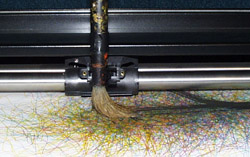ARTST 102 Algorithmic Visualization
Terry Giang
Roman Verostko and the Extended Artists' Hand
A short history on the extention of the artists' hand and the development
of algorithmic art throught the ages.
If algorithm is a detailed layout of procedures needed to carry out an
action or task, algorithmic art is artworks made in a systematic manner.
We rely so much on the performance of algorithms in our lives; why not
appreciate it for its artistic qualities too. During the beginning period
of human civilization, the concept of math, organization and the repetition
of tasks were already prevalent, exemplified by structures from the Egyptian
and Byzantine empires. Stonehenge is another great example were algorithm
is used to erect the stones in accordance with the cycles of the sun and
moon. The great pyramids and citadels of the ancient world are all considered
to be great works of art and the fact that they all utilize a quality
of mathematics and systematic procedures that is what makes them an algorithmic
work of art. Algorithm also plays a significant part in the patterns that
emerge from Islamic art. The symmetrically balanced and perfected complexities
of the intricate patterns deal with the systematic performance of lines
and shape.
As the advent of machines and computers begin to rise, algorithmic art becomes a much more interesting concept. In the 20th century, these devices become the middle man and or medium for a new type of art. Artists like Harold Cohen, Jean Pierre Hebert and Mark Wilson, all use algorithmic related mechanisms to create works. The art looks abstracted but has an organic quality, but because a machine carried out the work so it looks very systematic with clean-cut lines. This type of art can be categorize with the abstract art, but also non-objective and non-representational. Artist like Roman Verostko worked to develop a form generating mechanism that will perform a programmed task. What this basically means is that the machine is designed to plot out points designated by data that is entered into a computer. It is able to switch pens depending on the color of the line and use a brush for more gestural look.

The brush plotter that creates gestural strokes like chinese characters

This is a close-up on the pen plotter with the brush added to it.

Example of the pen plotter and what it can creat
This whole concept of digital art verses traditional art becomes a really interesting dilemma, is it really art if a machine produced it? This is where most would argue that the artistic concept comes from the algorithmic procedures that is what makes it art. Some contemporary artists take on very difficult procedures to complete a work, but it is the difficulty of the procedures which makes the piece powerful. For example Christo Javacheff and Jeanne-Claude Guillebon (Running Fence) made series of location specific installations. Take one of their work and break it down to its individual parts and basically the piece would loose its intensity. It is the difficulty, number and size of the piece which gives it dynamic and make it art. The fact that the piece was over 24 miles long and used more than 240,000 square yards of woven nylon, was the difficult task. In the same way, algorithmic art has its legitimate place in the art world because the difficulty in writing the code is the task that needs to be overcome by the artist in order for the piece to be made. In other words, although the end product is disconnected from the actual hands, the work is still aesthetically pleasing. In this case, the artist has become a designer, were he or she no longer physically carry out the task of art making but is replaced by a machine. This notion is also a very important concept introduced to society by the more frequent use of technology, now that society relies upon cash registers, electronic dictionaries and computers we no longer perform physically straining labor, such as building a fire. Algorithmic art can be thought of in the same way, where the artists' hand is completely removed from the labor that goes into making the art work. Art and its functions have come a long way as far as calculations to line structures up with celestial bodies, to having machines draw the image designed by the artist. Because the procedures and steps that it takes to complete the task are noted in the code, the end product can be considered to by algorithmic art.
Verostko, Roman. Algorithmic Art composing the score for
visual art. http://www.verstko.com.algorithm.html
http://www.verostko.com/alg-isea94.html
http://www.groboto.com
http://www.gris.uni-tuebingen.de/people/staff/reinnard/simplification.html
http://www.georgeheart.com/rp/rp.html